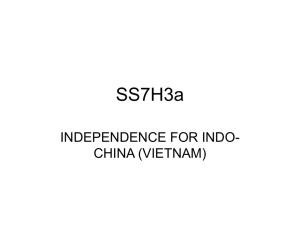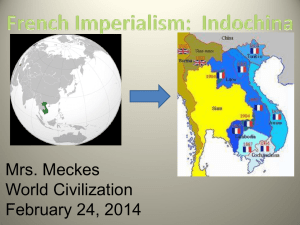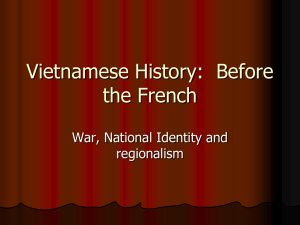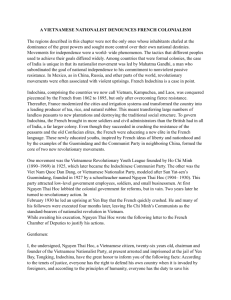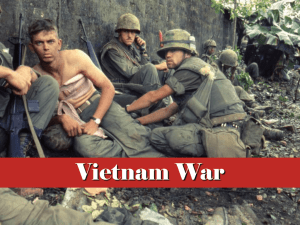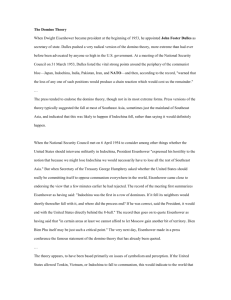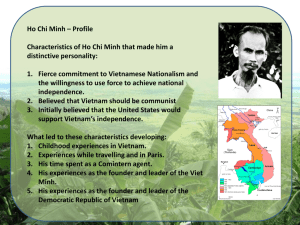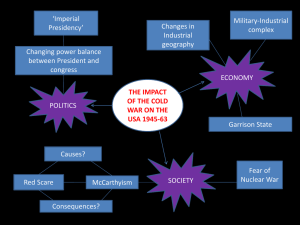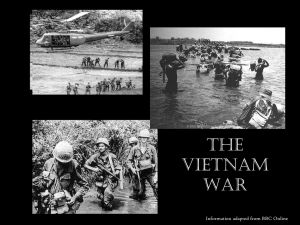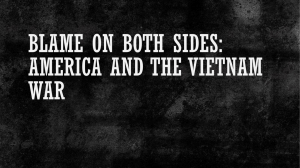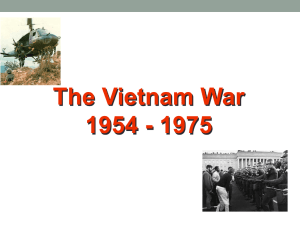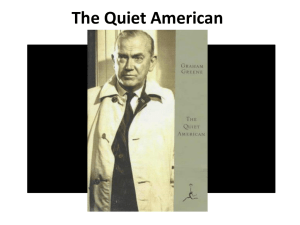French Indochina, 1885-1954
advertisement
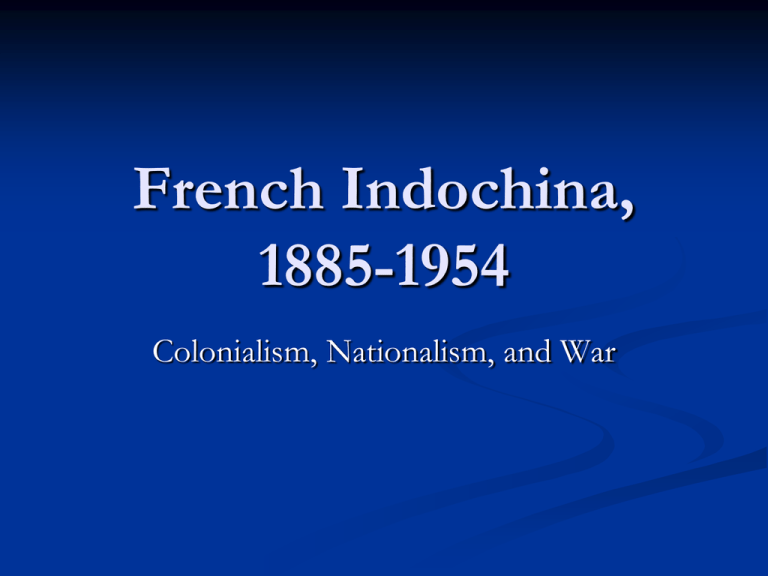
French Indochina, 1885-1954 Colonialism, Nationalism, and War French Indochina The Arrival of the French 1.) First Missionaries in 16th, 17th Century Portuguese, French 2.) France – direct involvement in early 19th century 3.) Conquest of Cochin China, 1862 4.) Tonkin and Annam 1884-1885 Impact of the French 1.) Coercive power 2.) Export-oriented economy 3.) Transformation of Vietnamese society, cash economy, divide between colonial urban elite and rural villages 4.) Political repression Resistance 1.) Can Vuong movement (1885-1889)– “Aid the king” Traditional Vietnamese resistance, centered in Annam, sought to restore the imperial system Attacks on Vietnamese Christians – 40,000 killed (a third of the total) Revolt crushed by the French, capture of the king Vietnamese Nationalism 1.) Phan Boi Chau, (1867-1940) – “Vietnamese Modernization Association” Inspired by Japanese victory in RussoJapanese war; looked to Japan first, then China after 1911 Revolution Sought modernization of Vietnam, independence and a republic Jailed by the French; died under house arrest Phan Boi Chau Impact of World War I 1.) 50,000 Vietnamese troops and 50,000 Vietnamese workers in Europe – 30,000 killed in the war 2.) Heavier taxes produced sporadic revolts in Vietnam 3.) Versailles conference – demands for self-determination Ho Chi Minh Facts about Ho 1.) Born Nguyen Tat Thahn, 1890, Nghe An province 2.) Son of Imperial office holder 3.) Left Vietnam in 1912 4.) Agitated for independence at Versailles 5.) Joined French Communist party in 1920 – Lenin’s Essay on Imperialism – the Highest Stage of capitalism “6.) Formed Indochinese Communist Party – 1930 – belief in revolutionary potential of the peasantry Interwar Era – Challenges to the French 1.) Economic protectionism heightened importance of colonial territories – trade barriers made Indochina more significant 2.) Increasing Nationalist activity – formation of the VNQDD – Vietnamese Nationalist Party – modeled on Kuomintang (Nationalist Party) of China 3.) VNQDD Yen Bay revolt in 1930 – leadership destroyed; remnants flee to China 4.) Destruction of more moderate nationalist groups – communists survived through disciplined organization and secrecy Indochina in 1940 The US as a Pacific Power, 1898-1941 1.) Westward Expansion 2.) Acquisition of Philippines as colony in 1898; Hawaii brought into union 3.) Interest in China Market – the Open Door notes – role of missionaries and traders 4.) Fears of Japanese power, vulnerability of the Philippines Japanese Expansion World War II and French Indochina 1.) French in Indochina stayed loyal to Vichy, the collaborationist government 2.) Tripartite Pact of Sept. 1940 ties Germany, Japan, and Italy – Japan receives landing rights in Indochina 3.) Japanese occupy Indochina – July 1941 – Roosevelt imposes sanctions 4.) Pearl Harbor attack – December 1941 Roosevelt vs. De Gaulle Wartime debate 1.) FDR favored trusteeship 2.) Problems with De Gaulle 3.) Role of Churchill 4.) US acquiescence to French return, low priority of Indochina The War Years 1.) Japanese domination 2.) Ho creates the Viet Minh as umbrella nationalist organization 3.) Famine – 1944 and 1945 4.) Japanese Coup March 1945 5.) OSS (Office of Strategic Services) works with Viet Minh to save US pilots 6.) August Revolution – Ho proclaims the DRV (Democratic Republic of Vietnam) – appeals for American support Post-1945 Vietnam 1.) Vietnam divided between Chinese and British 2.) Ho worked to get the Chinese out and replaced by the French. “The last time the Chinese came, they stayed a thousand years. The French are foreigners. They are weak. Colonialism is dying. The white man is finished in Asia. But if the Chinese stay now, they will never go. As for me, I prefer to sniff French shit for five years than to eat Chinese shit for the rest of my life." Vietnam 1945-1946 • 1.) Agreement with France, March 1946 (French government has communist representation) • Ho-Sainteny agreements • Recognition of the DRV, future elections, but allowing 15,000 French soldiers to be stationed in the North Outbreak of Franco-Viet Minh War ► 1.) Continuing tensions – French sabotage in Cochin-China ► 2.) Ho goes to Paris August 1946 for negotiations ► 3.) Outbreak of fighting Nov. 1946, shelling of Haiphong, Viet Minh pull out of Hanoi into Northern countryside The US and the Franco-Viet Minh War, 1947-1950 1.) Sympathetic Neutrality - State Department can offer no good alternative 2.) Primacy of Europe – era of the Cold War, Truman Doctrine, Marshall Plan, concern about Soviet power in Europe – France as the key country for US purposes 3.) Weakness of France politically – coalition governments, strong communist party – the leverage of the weak 4.) NATO in 1949 – first US peacetime alliance 5.) NSC 68 – strategic reassessment, importance of Southeast Asia French Policy 1.) Control of the cities – use of the Foreign Legion 2.) Bao Dai Solution The Cold War turns hot, 1950 1.) Soviet A-bomb Sept. 1949, Fall of China Oct. 1949, McCarthyism Feb. 1950 (Wheeling West Virginia Speech) 2.) US decides to provide $15 million to Bao Dai, May 1950 – connected to agreements in Europe to beef up NATO, eventually rearm Germany 3.) Outbreak of the Korean War, June 1950 The Korean War - Events 1.) Invasion by the North, June 1950 2.) UN sanction – Pusan Perimeter August 1950 3.) Inchon landing – September 1950 4.) Advance North to the Yalu, Oct. 1950 5.) Chinese Intervention, November 1950 6.) Stalemate, April 1951, firing of MacArthur 7.) Inconclusive fighting, peace talks, 1951-1953 8.) Election of Eisenhower, Nov. 1952 9.) Armistice, July 1953 The Impact of Korea on Vietnam 1.) War seen as part of the same strategic theatre 2.) Increase to $133 million in aid 3.) French position weakens in late 1950; defeat at Cao Bang – Chinese role in helping Vietnamese 4.) French General Jean de Lattre de Tassigny, WWII hero, – some success in 1951; appealed for more American aid; created a Vietnamese National Army US-French Tensions over the War 1.) French refusal to grant Vietnam independence 2.) American calls for a more aggressive strategy 3.) Connection between French cooperation in Europe with EDC (European Defense Community) and policy in Indochina Eisenhower 1.) Elected on vow to go to Korea John Foster Dulles as Secretary of State Eisenhower and Vietnam 1.) Recognized weakness of French will to fight 2.) Pushed the French to adopt a more aggressive strategy, train more Vietnamese soldiers, offer greater independence to Bao Dai government 3.) U.S. paid 80 percent of the costs Indochina in 1954 1.) US support for the French – paying up to 80 percent by 1954 Battle of Dien Bien Phu – April-May 1954 2.) Eisenhower’s “United Action” policy – the “domino theory” 3.) US reluctance to intervene 4.) French Defeat – May 1954 YouTube - John Foster Dulles on the Fall of Dien Bien Phu (1954) Geneva Conference of 1954 1.) Division of Vietnam at 17th Parallel 2.) Elections in two years 3.) Movement of peoples North and South 4.) US takes “note” of the agreements, but is not a party to them Ho Chi Minh vs.Ngo Dinh Diem
